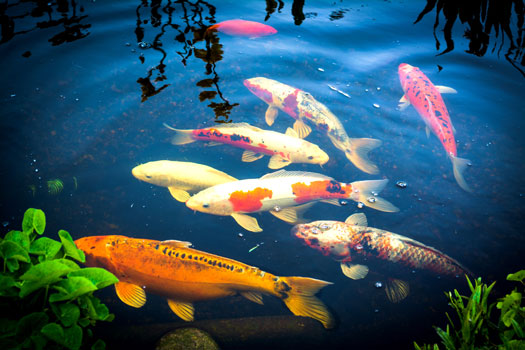- Your shopping cart is empty!
6 Causes of Water Loss in Koi Ponds

All garden ponds are bound to experience loss of water. Even natural aquatic habitats go through this process, but the difference is that koi ponds are exposed to even more external factors that can result in lower water levels. Adequate depth is crucial for koi and other garden pond species, which is why it’s important to learn why water loss may take place. The trusted staff at Aquatic Warehouse, a leading provider of koi pond supplies, has put together a list of six reasons your koi pond might be losing water.
1. Water Evaporation
This natural process is even more prominent in regions where the summer months feature higher temperatures and more sunshine. It doesn’t matter if the regional climate is dry or humid. As long as the rays of the sun cause temperatures to rise above 75 degrees Fahrenheit, you can expect water levels to drop about an inch per week.
2. Splashing Fountains
Waterfalls and fountains aren’t only great pond decorations. Their mechanical systems also promote greater aeration by means of water displacement. The only issue with these pond features is that they can increase water loss, particularly during windy days.
3. Liner Tears
Flexible liners are less likely to experience tears and rips than preformed fiberglass pond shapes that have a tendency to crack, but both can fail for numerous reasons. A very small tear can occur while installing sharp rocks, or a sharp root may not be noticed at installation.
4. Filtration at the Edges
This may almost seem like water spilling over, but it’s more like water escaping because the liner has been unevenly positioned. When setting up a pond for the first time so the nitrogen cycle is established, it’s important to look for signs of the liner settling after the substrate and water have been added. It’s better to have the material going over the edge than to risk the potential of it detaching away from the edge, which will result in unwanted filtration.
5. Leaks at the Pumping Systems
After climate-related evaporation, this is the most common reason for ponds to lose water. Whether the mechanism is exposed or covered for maximum aesthetics, it can be nonetheless difficult to detect because of evaporation. A small leak that never drips down to form a puddle will be virtually invisible. Coating the pipes, joints, seals, and packing with petroleum jelly is one way to detect mechanical system leaks. In some cases, the leak may be related to a blockage of the pond filters, which can result in overflowing and spillage. This can be easily solved by removing the filter media and hosing it down.
6. Thirsty Plants
By virtue of being aquatic species, pond plants will consume water while at the same time doing a great service to the biochemistry of the ecosystem. If you have floating lilies of the flowering kind, you can expect them to consume more water during the summer. If you have terrestrial plants that start to dip into the water surface, you may also notice water loss.
Maintaining a good water level is just one of the many tasks when caring for a koi pond. Having the right supplies on hand is essential and can make pond care much easier. Whatever you need for your pond can be found at Aquatic Warehouse. Take a look at the many high-quality products available on our website, stop by our store in Kearny Mesa, or give us a call at 858-467-9297 if you have any questions.
